As a pet expert, I often get asked the question, can a cat kill a dog? It’s a topic that sparks curiosity and concern among pet owners. In this article, we will dive into the dynamics of cat and dog interactions to uncover the truth behind this common query.
Cats and dogs have long been portrayed as enemies, but is there any truth to the idea that a cat can overpower a dog in a fight? Let’s examine the behavior and instincts of both cats and dogs to understand how these furry friends interact with each other.
Key Takeaways:
- While it is unlikely for a cat to kill a dog due to the significant difference in size and strength, cats can defend themselves using their agility and quick reflexes.
- Cat and dog behavior depends on individual temperament, training, and socialization.
- Creating a safe environment and supervising interactions between pets is crucial for maintaining a harmonious relationship.
- Proper introductions, gradual acclimation, and positive reinforcement are key to fostering a positive bond between cats and dogs.
- Seeking advice from a professional trainer or behaviorist can provide valuable insights for successful pet introductions.
Cats as Natural Predators
Cats are fascinating creatures with a natural instinct for hunting. Their predatory behavior is deeply ingrained, making them excellent hunters in the wild. With sharp claws, keen eyesight, and hunting instincts, cats are equipped to pursue and capture their prey. These hunting skills also come into play when a cat feels threatened by a dog.
When confronted by a dog, a cat’s natural predator instincts kick in. It may perceive the dog as a potential threat and respond by displaying defensive behavior. Cats have the ability to use their claws and teeth for self-defense, delivering quick and precise strikes to protect themselves.
It’s important to note that not all cats react the same way when confronted by a dog. Their behavior depends on various factors, such as their temperament, past experiences with dogs, and the size and behavior of the dog in question. Some cats may choose to flee and hide, while others may stand their ground and defend themselves.
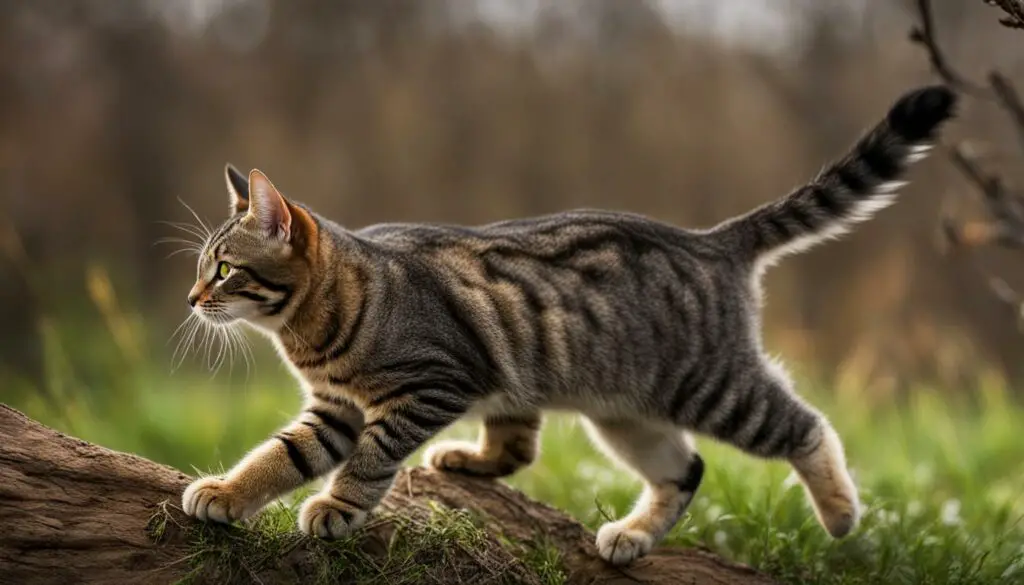
Understanding Cat Self-Defense
When a cat feels threatened, it may adopt defensive postures to ward off potential danger. These postures include arching the back, puffing up the fur, and hissing or growling to communicate its discomfort. The cat may also lash out with its claws or bite if necessary.
While cats possess impressive self-defense mechanisms, it’s important to remember that they are not invincible. Their smaller size and weaker bite strength put them at a disadvantage in a confrontation with a dog.
That being said, cats can still hold their own against dogs using their agility and quick reflexes. Their ability to climb trees, scale fences, and maneuver through tight spaces gives them an advantage in escaping from a pursuing dog. Additionally, their sharp claws can inflict painful scratches, deterring a dog from further aggression.
Overall, while cats are natural predators with self-defense capabilities, their ability to defend themselves against a dog depends on various factors including size, strength, and individual behavior traits. Understanding and respecting these dynamics is essential for the safety and well-being of both cats and dogs.
Dogs as Domesticated Animals
When it comes to dog behavior, it’s important to understand that dogs are domesticated animals with a range of instincts and characteristics. These instincts can play a role in how they interact with other animals, including cats. While dogs have a natural prey drive that can make them inclined to chase small animals like cats, it doesn’t mean that all dogs are inherently aggressive towards them.
The behavior of dogs towards cats can vary depending on their individual personalities, their level of training and socialization, and their past experiences with cats. Some dogs may show curiosity towards cats, while others may be more inclined to be friendly and tolerant. Proper training and socialization can help dogs learn how to behave appropriately around cats and reduce any potential aggression or prey drive.
It’s important for pet owners to take the time to introduce their dog and cat in a controlled and supervised environment. This allows both animals to become familiar with each other’s presence and establish boundaries. Gradual introductions can help alleviate any stress or fear that either animal may have and increase the likelihood of a positive and harmonious relationship between the two.
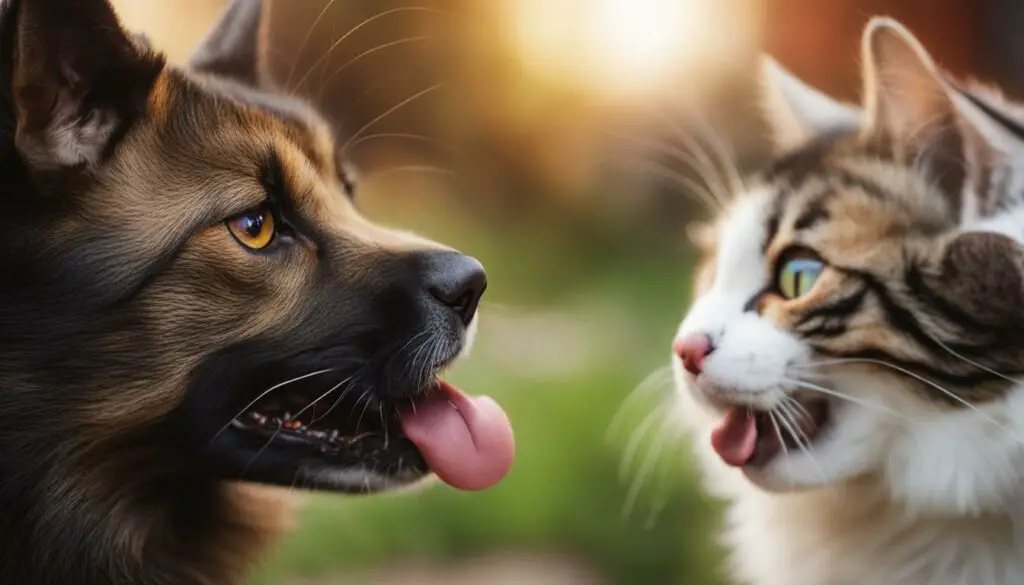
Safety Tips for Dog and Cat Interactions:
- Always supervise interactions between your dog and cat to ensure their safety.
- Provide separate spaces and resources for each pet to prevent unnecessary conflicts.
- Gradually introduce your dog and cat in a controlled environment, allowing them to become familiar with each other’s scent and presence.
- Use positive reinforcement and reward-based training methods to encourage desired behavior from both pets.
- Consult with a professional trainer or behaviorist for guidance on managing dog and cat interactions if needed.
By understanding the instincts and behavior of dogs as domesticated animals, pet owners can create a safe and harmonious environment for their dogs and cats to coexist peacefully.
| Dog Behavior | Cat Behavior |
|---|---|
| Dogs have a natural prey drive that can make them inclined to chase small animals like cats. | Cats are more agile and have sharp claws and teeth that they can use for self-defense. |
| Some dogs may show curiosity towards cats, while others may be more inclined to be friendly and tolerant. | Not all cats will react the same way in the presence of dogs. Their behavior depends on their temperament and the size and behavior of the dog. |
| Proper training and socialization can help dogs learn how to behave appropriately around cats and reduce any potential aggression or prey drive. | Proper introductions and gradual acclimation can help cats feel more comfortable and reduce stress in the presence of dogs. |
Size and Strength of Cats and Dogs
When comparing cats and dogs, one of the notable differences lies in their size and strength. Dogs, being domesticated animals, tend to be larger and stronger than cats. The size and strength of dogs vary depending on their breed, while cats, in general, are smaller and more agile.
Cat size: Cats come in different sizes, with the average domestic cat ranging from 9 to 10 inches in height and weighing between 7 and 11 pounds. Some larger breeds of cats can weigh up to 20 pounds or more.
Dog size: Dogs, on the other hand, vary significantly in size, ranging from small breeds like Chihuahuas that stand around 6 inches tall and weigh less than 6 pounds, to giant breeds like Great Danes that can reach heights of over 30 inches and weigh up to 200 pounds or more.
Strength and Agility: In terms of strength, dogs have an advantage over cats due to their larger size and more robust musculature. Dogs have stronger jaw muscles and bite force, which can vary depending on the breed. Cats, although smaller, make up for their lack of strength with their agility and quick reflexes. Their lightweight bodies enable them to move swiftly, jump, and climb with ease.
Overall, the size and strength difference between cats and dogs play a role in their ability to defend themselves in a fight. While dogs may have the advantage in terms of size and strength, cats rely on their agility and sharp claws to protect themselves when necessary.
Table: Size and Weight Comparison of Cats and Dogs
| Breed | Average Height (in inches) | Average Weight (in pounds) |
|---|---|---|
| Domestic Cat | 9-10 | 7-11 |
| Maine Coon | 9-10 | 13-18 |
| Ragdoll | 9-11 | 10-20 |
| Chihuahua (Toy breed dog) | 6-9 | 2-6 |
| Golden Retriever | 21-24 | 55-75 |
| Great Dane | 30-34 | 110-190 |

“While dogs may have the advantage in terms of size and strength, cats rely on their agility and sharp claws to protect themselves when necessary.”
Can a Cat Defend Itself Against a Dog?
When it comes to a cat defending itself against a dog, it’s important to consider the dynamics of the situation. While a cat can employ its natural self-defense mechanisms, such as sharp claws and teeth, to protect itself, there are several factors that can impact the outcome of a cat and dog fight.
One key factor is the size and strength difference between cats and dogs. Dogs typically have a larger size and stronger bite, giving them an advantage in a physical altercation. Additionally, a cat’s agility and quick reflexes can help it evade a dog’s attack, but it may struggle to overpower a larger and more powerful opponent.
Furthermore, the behavior of both the cat and the dog during a confrontation can influence the outcome. If the cat displays aggression or stands its ground, it may deter the dog from attacking or encourage the dog to retreat. On the other hand, if the cat shows fear or attempts to flee, it may trigger the dog’s predatory instincts and escalate the situation.
| Factors Influencing Cat Defense Against Dogs | Potential Outcome |
|---|---|
| Size and strength difference | Dog has advantage |
| Cat’s agility and quick reflexes | Helps evade dog’s attack |
| Cat’s behavior (aggression/fear) | Can deter or escalate the situation |
“While a cat can defend itself against a dog, the odds may not be in its favor due to the significant size and strength difference between the two. Nevertheless, cats can rely on their agility and self-defense mechanisms to hold their ground and protect themselves.”
Examples of Cats Defending Themselves Against Dogs
There have been numerous instances where cats have shown their bravery and successfully defended themselves against dogs. One remarkable example is the story of Tara, a fearless house cat who courageously chased away a neighbor’s aggressive dog to protect her young owner. This heartwarming incident went viral and highlighted the innate courage and protective instincts that cats possess.
Another instance of a cat defending its owner from a dog attack is the case of Whiskers. When a stray dog approached Whiskers’ owner with aggressive intentions, Whiskers quickly leaped into action. With lightning-fast reflexes, the courageous cat fearlessly pounced on the dog, surprising it and giving the owner enough time to escape to safety. Whiskers’ bravery and loyalty exemplify the strong bond that can develop between cats and their human companions.
Furthermore, cats have been known to defend vulnerable individuals from dog confrontations. In one heartwarming story, a cat named Max protected a young child from an approaching dog in a park. Max positioned himself between the child and the dog, hissing and lashing out with his claws to deter the dog from getting any closer. This incident highlighted the protective nature of cats and their ability to come to the aid of those in need.
| Examples of Cats Defending Themselves Against Dogs |
|---|
| Tara chases away an aggressive dog to protect her young owner |
| Whiskers defends its owner from a stray dog attack |
| Max protects a young child from an approaching dog in a park |
These real-life examples demonstrate that cats are not to be underestimated when it comes to defending themselves and others against dogs. While the size and strength difference between cats and dogs may pose a challenge, cats rely on their quick reflexes and sharp claws to hold their ground. Their ability to fend off potential threats emphasizes the remarkable resilience and bravery of our feline friends.
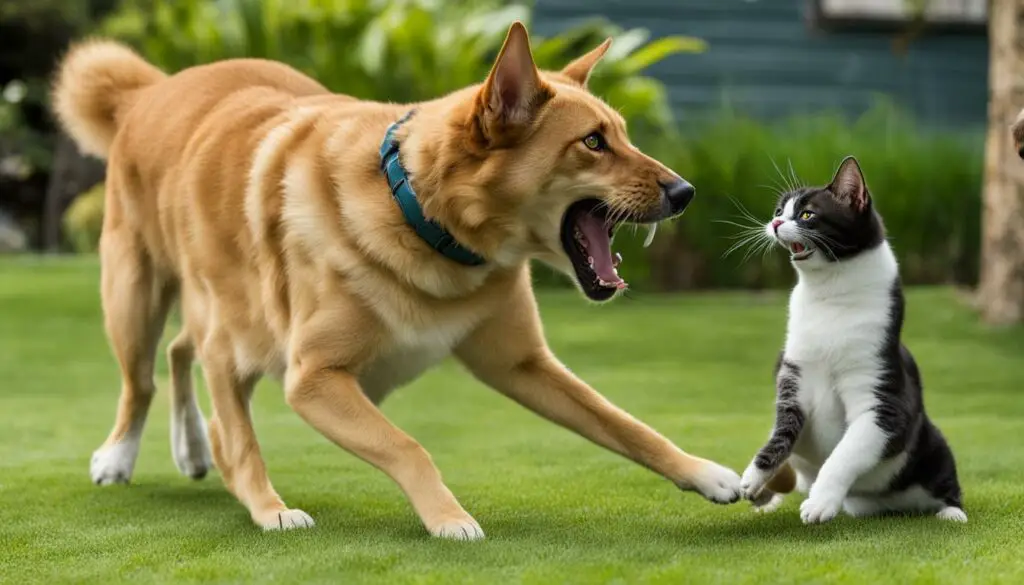
Expert Quote
“I have seen firsthand the incredible instinct and courage displayed by cats when facing off against dogs. While they may be smaller in size, their agility and fierce determination make them formidable opponents. These examples serve as a reminder of the unique qualities that cats bring to our lives.” – Pet Expert
Understanding Cat and Dog Interactions
When it comes to the interaction between cats and dogs, it’s important to recognize that these two species have different instincts and behaviors. Understanding their natural tendencies can help create a harmonious relationship between them. Proper introductions and supervision are key to ensuring their safety and well-being.
Introducing Cats and Dogs
When introducing a cat and a dog, it’s crucial to do so gradually and in a controlled environment. Start by allowing them to become familiar with each other’s scent by exchanging bedding or toys. Next, introduce them through a barrier such as a baby gate or a crate, allowing them to see and smell each other without direct contact. Supervise their reactions and ensure that both pets feel safe and comfortable.
As the introduction progresses, gradually increase their face-to-face interactions. Always prioritize positive reinforcement and reward calm and friendly behavior. It’s important to never force interactions and to respect each pet’s boundaries. Some cats and dogs may take longer to adjust and may require additional time and patience.
Creating Separate Spaces
Giving each pet their own designated space is crucial for their well-being. Cats should have access to high perches, hiding spots, and scratching posts, allowing them to escape and observe from a safe distance. Dogs should have their own beds and areas where they can relax undisturbed. Providing separate spaces helps prevent potential conflicts and allows each pet to have their own territory.
| Cat Space | Dog Space |
|---|---|
| High perches | Comfortable bed |
| Hiding spots | Relaxation area |
| Scratching posts | Toys and chew bones |
Supervising Interactions
Even after successful introductions, it’s crucial to continue supervising interactions between cats and dogs. This ensures their safety and allows for immediate intervention if necessary. Observe their body language and behavior, looking for signs of tension or stress. Redirect their attention if they show signs of aggression or fear. Always prioritize the well-being of both pets and be prepared to separate them if needed.
Remember, the relationship between cats and dogs can vary greatly depending on the individual animals involved. Some cats and dogs may become fast friends, while others may tolerate each other but prefer to keep their distance. Patience and understanding are key to fostering a positive and peaceful interaction between these beloved furry friends.
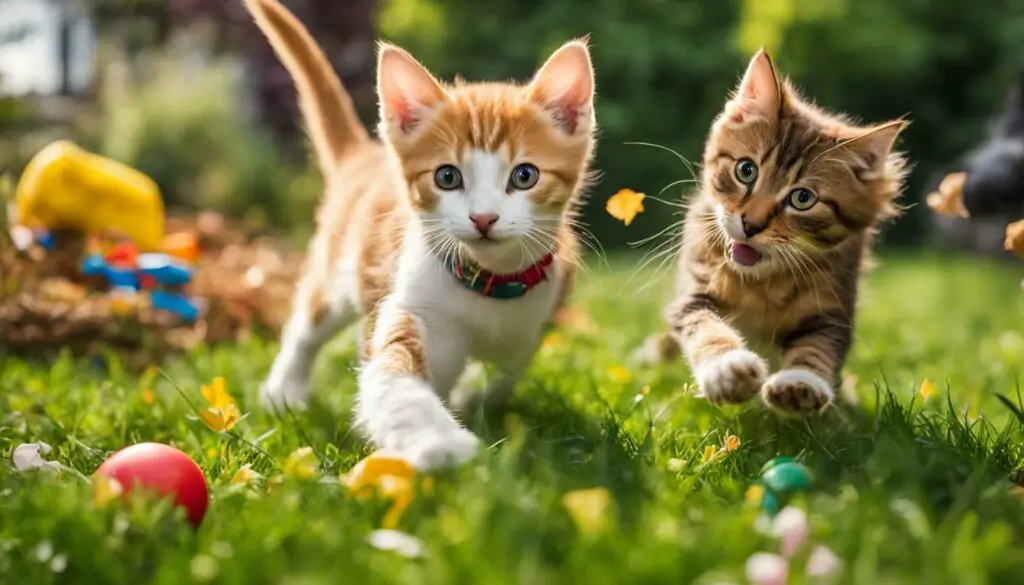
Pet Supervision and Safety: Ensuring Harmonious Cat and Dog Interactions
When it comes to introducing cats and dogs to each other, pet supervision is key to ensuring their safety and promoting a harmonious relationship. Whether you are bringing a new pet into your home or introducing your existing cat or dog to a new companion, it is essential to closely monitor their interactions.
During the initial introductions, it is important to keep both pets on a leash or in separate, controlled environments. This allows you to gauge their reactions and prevent any aggressive behavior that could potentially lead to injury. Gradual acclimation is crucial, as it gives the pets time to adjust to each other’s presence and reduces the likelihood of conflict.
Supervision also involves actively observing their body language and intervening when necessary. Signs of aggression or stress, such as growling, hissing, raised fur, or a tense posture, should be addressed immediately. In such situations, calmly separate the pets and give them time to calm down before trying another introduction.
Common Mistakes to Avoid:
- Leaving the pets unsupervised during the initial introductions
- Forcing interactions or allowing them to escalate into aggressive behavior
- Ignoring signs of stress or aggression
- Introducing them in a high-stress environment or too quickly
By prioritizing pet supervision and safety, you can create a positive and safe environment for both your cat and dog. Remember, each pet is unique, and their interactions may take time and patience. With your careful guidance and proper supervision, you can help foster a harmonious relationship between your beloved furry friends.
| Pet Supervision Tips: | Pet Safety Tips: |
|---|---|
| Always be present during the initial introductions. | Ensure a secure environment for both pets, providing separate spaces if necessary. |
| Use positive reinforcement and rewards for calm and appropriate behavior. | Regularly check the living area for potential hazards or escape routes. |
| Provide each pet with their own food, water, and litter box to avoid competition. | Keep small objects and toxic substances out of reach. |
| Observe their body language and intervene if aggression or stress occurs. | Ensure both pets are up-to-date on vaccinations and preventative care. |
| Allow the pets to set the pace of their interactions and gradually increase the time they spend together. | Consider using pheromone diffusers or calming aids to reduce anxiety. |
Creating a Safe Environment for Cats and Dogs
When it comes to ensuring the safety of your pets, creating a safe environment is of utmost importance. By following a few key steps and implementing certain measures, you can provide both cats and dogs with a secure and harmonious living space.
Pet Separation
To maintain a safe environment for both cats and dogs, it is essential to establish separate spaces for each pet. This can be achieved by designating specific areas in your home where each pet can retreat to when they need their own space. Providing separate sleeping areas, feeding stations, and litter boxes for cats can help prevent territorial disputes and reduce stress.
Pet Training
Proper training is crucial for ensuring the safety and well-being of both cats and dogs. Dogs should be trained to behave appropriately around cats, teaching them commands such as “leave it” or “stay” to prevent any unwanted interactions. Additionally, basic obedience training can help establish boundaries and create a sense of structure within your household.
Supervision and Enrichment
Regular supervision is necessary when cats and dogs interact to prevent any potential conflicts. It is important to keep a watchful eye and intervene if necessary, especially during the initial stages of their interaction. Providing plenty of mental and physical stimulation through toys, scratching posts, and interactive play sessions can help redirect their focus and prevent any aggressive behavior.
| Cat Safety Measures | Dog Safety Measures |
|---|---|
| Ensure houseplants are non-toxic to cats | Secure fences and boundaries |
| Keep toxic substances out of reach | Provide proper socialization |
| Keep small objects and cords out of reach | Train them to respond to recall commands |
Remember, creating a safe environment for cats and dogs requires patience, consistency, and a deep understanding of their individual needs. By implementing these measures, you can help foster a peaceful coexistence between your furry friends and ensure their safety and well-being.

The Importance of Patience and Training
Pet training and acclimation are crucial factors in fostering a harmonious relationship between cats and dogs. Patience is key when introducing these two animals to each other, as it takes time for them to adjust to each other’s presence and develop a positive relationship. By following a structured training approach and providing consistent reinforcement, pet owners can help their pets acclimate and coexist peacefully.
Training should start with basic obedience commands for both cats and dogs. Teaching them commands like “sit,” “stay,” and “leave it” can help establish boundaries and prevent any potential conflicts. Positive reinforcement techniques such as treats, praise, and rewards can be used to encourage desired behaviors and create a positive association between the pets.
Additionally, it’s important to gradually introduce cats and dogs to each other under controlled circumstances. This can be done by exchanging their scents, allowing them to see each other through a gate, or having them in separate rooms but with a barrier like a baby gate. Over time, the distance between the two animals can be gradually reduced until they are comfortable being in closer proximity.
Remember, each pet is unique, and progress may vary. Some cats and dogs may develop a bond quickly, while others may take more time to adjust. It’s important to remain patient and consistent throughout the process, avoiding any forceful interactions or punishment. With time, training, and patience, cats and dogs can learn to coexist peacefully and even form lasting friendships.

Training Tips for Cats and Dogs
- Start with basic obedience commands
- Use positive reinforcement techniques
- Gradually introduce cats and dogs under controlled circumstances
- Be patient and consistent throughout the process
Expert Advice for Pet Owners
As a pet expert, I have years of experience working with cats and dogs and helping pet owners navigate the challenges of introducing these furry friends. When it comes to pet introductions, it’s important to approach the process with patience and care. Every pet is unique, and their initial interactions can set the tone for their future relationship.
One of the first steps in introducing a cat and dog is to create a safe and controlled environment. This means providing separate spaces for each pet initially and gradually allowing supervised interactions. It’s also crucial to set realistic expectations and understand that it may take time for your pets to become comfortable with each other.
In addition to providing a safe environment, proper training is key. Training your dog to have good manners around the cat and teaching them basic obedience commands can go a long way in preventing any potential conflicts. Similarly, it’s important to understand cat behavior and provide them with spaces where they can feel secure and retreat if needed.
| Expert Advice for Introducing Cats and Dogs | Pet Safety Measures |
|---|---|
| Gradually introduce the pets to each other, starting with scent exchange and then supervised visual interactions. | Keep pets on leashes or behind baby gates during initial introductions to prevent any sudden confrontations. |
| Use positive reinforcement techniques, such as treats and praise, to reward calm and friendly behavior from both pets. | Provide separate feeding areas for each pet to avoid resource guarding and reduce the likelihood of conflicts. |
| Keep interactions short and positive, gradually increasing the duration as both pets become more comfortable. | Seek professional guidance if you notice signs of aggression or excessive fear from either pet. |
Remember, ensuring the safety and well-being of both your cat and dog should be your top priority. By following expert advice, remaining patient, and providing proper training, you can increase the chances of a harmonious and loving relationship between your pets.
Expert Tips for Successful Pet Introductions
- Allow pets to explore each other’s scents before introducing them visually.
- Keep initial interactions short and positive, gradually increasing their duration over time.
- Provide separate spaces and resources for each pet to reduce potential conflicts.
- Supervise all interactions between your cat and dog, intervening if necessary.
- Consult a professional trainer or behaviorist if you encounter any challenges or signs of aggression.
Cat vs Dog Conclusion: Fostering a Pet Harmonious Relationship
In conclusion, the dynamic between cats and dogs is complex and diverse, with each pet having its own unique behaviors and instincts. While it is highly unlikely for a cat to kill a dog in a one-on-one confrontation, cats can defend themselves using their agility and quick reflexes.
To ensure a harmonious relationship between cats and dogs, it is essential for pet owners to prioritize safety and provide a safe environment for both pets. This includes closely supervising their interactions, creating separate spaces when necessary, and gradually acclimating them to each other’s presence.
Proper introductions, positive reinforcement, and patience are key in fostering a peaceful coexistence between cats and dogs. By understanding their behaviors, training them appropriately, and seeking professional advice when needed, pet owners can build a strong and harmonious bond between their furry friends.

Expert Advice for Pet Owners
“It’s important for pet owners to be patient and understanding when introducing cats and dogs. Gradual progress and positive reinforcement are key to building a harmonious relationship.”
– Pet Behaviorist
Remember, each pet is unique, and it may take time for them to adjust to each other’s presence. With the right approach and consistent training, cats and dogs can live together in harmony, bringing joy and companionship to their owners.
You may also like:
If you found this article helpful, you may also find the following articles useful in understanding cat and dog relationships, pet behavior, and maintaining harmony between pets.
- Related Articles on Cat and Dog Relationships
- Tips for Understanding Pet Behavior
- A Guide to Maintaining Pet Harmony
These resources will provide you with valuable insights and practical advice in navigating the complex dynamics between cats and dogs, ensuring a harmonious coexistence in your home.

Expert Tips on Cat and Dog Relationships
“Creating a peaceful environment for cats and dogs requires careful consideration of their individual behavior and needs. Gradual introductions, supervised interactions, and positive reinforcement are key to establishing a harmonious relationship. Remember to be patient and seek professional advice if needed.”
– Dr. Lisa Thompson, Animal Behaviorist
| Cats | Dogs | |
|---|---|---|
| Temperament | Independent, cautious | Loyal, protective |
| Size | Smaller, agile | Varies by breed, larger |
| Communication | Body language, vocalizations | Body language, barking |
| Training | Responsive to positive reinforcement | Responsive to training, socialization |
Understanding the unique characteristics and needs of both cats and dogs will help you foster a positive and harmonious relationship between them. By following expert advice and being attentive to their individual personalities, you can create a loving and safe environment for your furry friends.
Creating a Safe and Happy Home for Your Pets
Ensuring a harmonious relationship between cats and dogs requires more than just introductory measures. Here are some additional tips to maintain pet harmony:
- Provide separate spaces for each pet to retreat to when needed.
- Establish consistent routines for feeding, playtime, and training.
- Offer mental stimulation through interactive toys and puzzle feeders.
- Monitor their behavior to prevent conflicts and address any signs of aggression or stress.
- Reward positive interactions between your pets with praise and treats.
By implementing these strategies and prioritizing your pets’ well-being, you can create a happy and harmonious home for both your cat and dog.
| Cats | Dogs | |
|---|---|---|
| Exercise | Play sessions, scratching posts | Regular walks, playtime |
| Grooming | Regular brushing, nail trimming | Bathing, regular grooming |
| Healthcare | Vaccinations, annual check-ups | Vaccinations, annual check-ups |
Remember, each pet is unique, and maintaining pet harmony requires ongoing effort and attention. By providing a loving and nurturing environment, understanding their individual needs, and seeking professional guidance when necessary, you can ensure a peaceful coexistence between your cat and dog.
References
As a pet expert, I have gathered information from various reputable sources to provide a comprehensive understanding of cat and dog behavior. Here are some references that you can explore for further insights:
PetMD
Website: www.petmd.com
PetMD is a trusted resource for pet owners, providing a wide range of articles and information on pet health, behavior, and training. Their cat and dog behavior sections offer valuable insights into understanding the behavior of both species and how they interact with each other.
The American Society for the Prevention of Cruelty to Animals (ASPCA)
Website: www.aspca.org
The ASPCA is a renowned organization dedicated to animal welfare. Their website offers a wealth of information on pet behavior, training, and introductions. Their articles provide practical tips and advice for pet owners looking to facilitate a harmonious relationship between cats and dogs.
International Cat Care (iCatCare)
Website: www.icatcare.org
iCatCare is a globally recognized organization focused on promoting feline health and welfare. Their website features a variety of resources on cat behavior, including guides on introducing cats to other pets, such as dogs. iCatCare’s articles are backed by scientific research and provide evidence-based recommendations.
The Humane Society
Website: www.humanesociety.org
The Humane Society is dedicated to the protection and well-being of animals. Their website offers helpful resources on pet behavior, including tips on introducing cats and dogs. The Humane Society’s articles emphasize positive reinforcement techniques and compassionate handling for successful pet introductions.
These references will serve as valuable sources of information for pet owners seeking a better understanding of cat and dog behavior. By consulting these reputable sources, you can gain insights and knowledge to help foster a harmonious relationship between your furry friends.
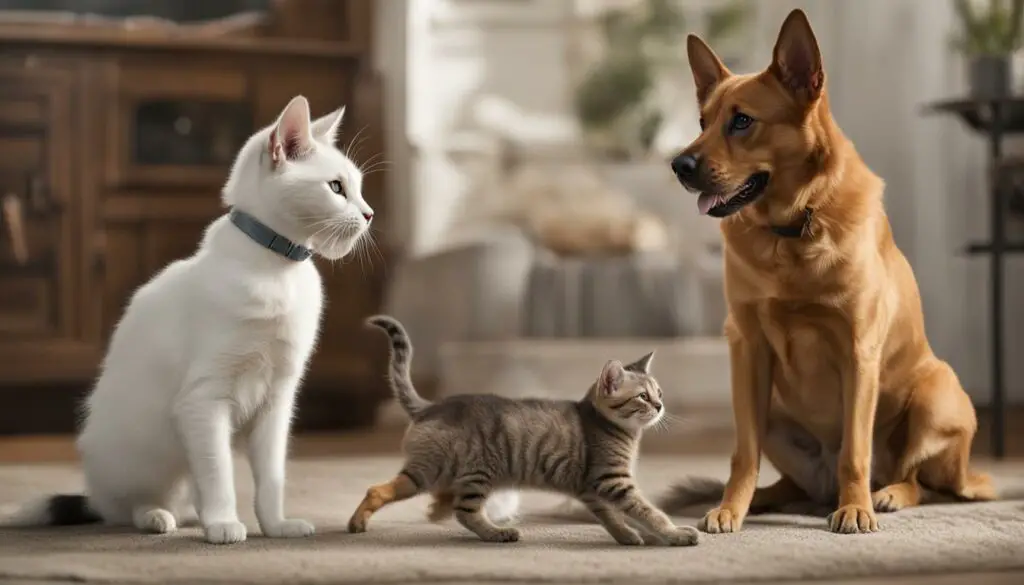
About the Author
As a pet expert with a deep understanding of cat and dog behavior, I am dedicated to sharing my expertise to help pet owners create harmonious relationships between their furry friends.
With years of experience in studying animal behavior and training, I have developed insights into the unique dynamics of cat and dog interactions. Through my work, I aim to provide valuable guidance to pet owners on introducing and managing their pets to ensure a safe and peaceful coexistence.
My passion for pets and their well-being is what drives me to continually educate myself and stay updated on the latest research and techniques in pet behavior. It is my belief that by understanding the instincts and needs of cats and dogs, we can foster positive relationships and create a loving environment for both pets and their owners.
Conclusion
In conclusion, while it is unlikely for a cat to kill a dog in a one-on-one confrontation due to the significant difference in size and strength, cats can defend themselves against dogs using their agility and quick reflexes. However, it is crucial for pet owners to prioritize safety, supervise their pets’ interactions, and provide a safe environment for both cats and dogs to coexist peacefully.
Remember, each pet is unique, and gradual introductions, positive reinforcement, and patience are key to fostering a harmonious relationship between cats and dogs. By understanding their natural instincts, behaviors, and individual personalities, pet owners can create a safe and supportive environment where their furry friends can thrive together.
So, whether you’re introducing a new cat to your resident dog or considering adding a dog to your feline family, take the time to observe and understand their interactions. With proper supervision, training, and a little bit of patience, you can help your cats and dogs build a strong bond and enjoy a peaceful coexistence.
FAQ
Can a cat actually kill a dog in a fight?
While it is unlikely for a cat to kill a dog in a one-on-one confrontation due to the significant difference in size and strength, cats can defend themselves against dogs using their agility and quick reflexes.
What are the natural instincts of cats?
Cats are natural predators equipped with sharp claws and teeth, excellent eyesight, and hunting instincts.
How do dogs behave towards cats?
Dogs have a natural instinct to chase small animals like cats, but their behavior towards cats depends on their individual personalities and level of training and socialization.
What is the difference in size and strength between cats and dogs?
Dogs tend to be larger and stronger than cats, but cats are smaller and more agile.
How do cats defend themselves against dogs?
Cats rely on their agility, quick reflexes, sharp claws, and teeth to protect themselves.
Can cats successfully defend themselves against dogs?
Yes, there have been instances where cats successfully defended themselves against dogs, demonstrating their resilience and courage.
How should cat and dog interactions be supervised?
It is important to closely supervise interactions between cats and dogs to ensure their safety. Proper introductions, gradual acclimation, and creating separate spaces for each pet are crucial.
What should pet owners do to create a safe environment for cats and dogs?
Pet owners should provide separate spaces for each pet, train the dog to behave appropriately around the cat, and teach basic obedience commands. Additionally, keeping the cat indoors or on a leash when outside can help prevent confrontations with dogs.
How important is patience and training in cat and dog relationships?
Patience and training are key in introducing cats and dogs to each other. It takes time for them to adjust to each other’s presence and develop a positive relationship.
What advice can a pet expert provide for cat and dog owners?
A pet expert recommends closely following the introduction process for cats and dogs, seeking professional advice, and ensuring the well-being and comfort of both pets.
Are there any related articles on cat and dog relationships?
You may also like articles on cat and dog relationships, pet behavior, and maintaining harmony between pets.






